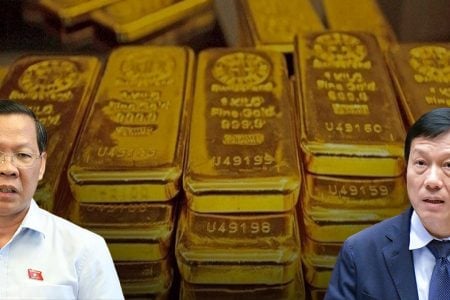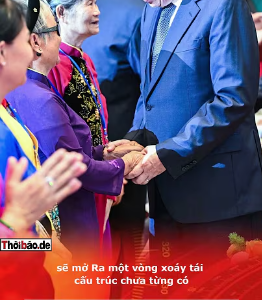
After ten years, the chair of the Association of Southeast Asian Nations (ASEAN) returns to Cambodia in 2022. However, this time, the regional situation has changed a lot, when the disputes in the South China Sea (Vietnam calls it the East Sea) and the US-China confrontation have become much more intense.
In the previous time holding the ASEAN chair, Cambodia created a negative impression by preventing ASEAN from issuing a joint statement, which was likely due to fear of offending China as many experts said.
Therefore, with this forecast that 2022 will be a challenging year for China-ASEAN relations, Cambodia is once again at the center of attention from not only countries in the region, but also from large foreign countries including the US.
For Vietnam, relations with its southwestern neighbor in 2022 are not limited to Cambodia’s role as ASEAN chair, and its influence on the negotiation process with China on the South China Sea issue but another very important issue that directly affects Vietnam’s security: China’s military moves close to the Vietnamese border on the Cambodian side.
The South China Sea continues to rise
The sovereignty disputes in the South China Sea are expected by experts to continue to become tense in 2022 when China is expected to become increasingly aggressive.
Commenting on this issue, Master Hoang Viet – an expert on East Sea Studies, said:
“The South China Sea issue in 2022 signals tension. Why? Because China will have its 20th party congress in 2022. Although now Xi Jinping is still the highest leader and wields great power in China, that doesn’t mean he doesn’t have opponents. Secondly, the problems of instability, smoldering in China’s heart still exist.
And China often uses the way of turning the fire outside, that is, using the external problem to push the internal contradiction out, and the South China Sea will be an important issue for China to push it out.“
In addition to internal factors, Hoang Viet also believes that competition for influence in the region with the US is another factor that makes China more aggressive this year, he said:
“In this year 2022, on January 19, China announced a live-fire drill in the East Sea, while the US side had 11 FONOPs in 2021, that is, patrols to ensure freedom of navigation in the East Sea, and 13 times dispatched aircraft carriers and escorts into the sea area.
Not to mention that we have seen other forces, including warships of European nations, and then other US allies such as Japan, Australia, and India participating in exercises as well as patrolling the East Sea area. And so it shows that the South China Sea becomes a very tense risk, and the danger of war is always near.”
In 2022, ASEAN countries and China will continue negotiations around the establishment of a Code of Conduct in the South China Sea (COC). Before taking over as ASEAN chair, Cambodian Prime Minister Hun Sen stated that he hopes to help ASEAN and China complete negotiations on this code.
However, Professor Carlyle Thayer from the University of New South Wales said that the prospect is not high, because the negotiation process has only taken place in the initial stage, not touching the thorny issues. So one year is not enough. He said:
“There will be no Code of Conduct this year. They’re still dealing with the basics and the easy first, like the opening and the general goals. They have not even negotiated the second part, which contains countless proposals from other countries, and Vietnam itself has its own proposal at the end, demanding to regulate what countries can and cannot do. So we have to wait and see how things play out.”
The risk of China placing military bases next to Vietnam
On January 21, 2022, the Center for Strategic and International Studies (CSIS) announced the discovery of a sand dredger at Cambodia’s Ream naval base. This raises the suspicion that the Phnom Penh government is renovating the Ream military port so that large warships can operate.
Since the information that China and Cambodia reached an agreement on the Southeast Asian country’s permission to China to use the Ream naval base, located close to the border with Vietnam, was announced to the US press in 2019, construction activities at this facility were detected frequently.
Dr. Le Hong Hiep, the senior research fellow at the Institute of Southeast Asian Studies, said that China’s military presence would threaten Vietnam’s security, so this is an issue that needs to be closely watched in the near future. He added:
“The issue that we need to keep an eye on in the near future is China’s military presence in Cambodia. If China really had a military presence in Cambodia it would create a so-called game-changer, a factor that could change Vietnam’s perception of Cambodia, as well as Vietnam’s perception of Cambodia’s relationship with China.”
Hiep also called China’s military presence in Cambodia a red line, which will make Vietnam rethink its policy with its southern neighbor, and possibly damage relations between the two sides.
Vietnam’s state-controlled media has enjoyed considerable freedom in recent years in reporting developments related to this issue.
In the context that the press environment in this one-party country has always been very strict, the press is not allowed to talk about sensitive issues in relations between Vietnam and neighboring countries, so according to Professor Carlyle Thayer, this is a sign that Vietnam is very concerned about China’s military presence in the south of Vietnam.
“It shows that Vietnam takes this issue very seriously, instead of letting the spokesman of the Ministry of Foreign Affairs or the Minister of Foreign Affairs talking about this issue, they let the press speak.
This serves Vietnam’s negotiating purposes, as it can play with words the way China does. We see that the Chinese still often cite a billion people for their arguments, Vietnam can also say that its people are disgruntled by this issue, and are demanding more information.
This is a ploy to put pressure on Cambodia.”
How should Vietnam respond?
With China’s influence growing in Cambodia, Vietnam is facing a huge challenge to secure its interests in the year that the neighboring country chairs ASEAN.
Regarding the South China Sea issue, Master Hoang Viet said that Vietnam might pursue the goal of maintaining the status quo, and avoiding pressure on Cambodia, he said:
“In general, I understand that Vietnam’s policy is first to maintain the status quo, second to support Cambodia as much as possible and thereby partially restrain Cambodia from making statements or actions that are detrimental to ASEAN’s solidarity on the East Sea issue.“
In fact, the senior leaders of Vietnam have recently made consecutive visits to Cambodia.
At the end of December 2021, President Nguyen Xuan Phuc paid a state visit to the country, and nearly a month later, it was the turn of the Minister of Foreign Affairs of Vietnam, Bui Thanh Son, to visit Cambodia.
This, according to Dr. Le Hong Hiep, shows that Vietnam attaches importance to maintaining and promoting the relationship with Cambodia to ensure its interests. But Mr. Hiep also said it would be difficult for Vietnam to compete for influence with China in Cambodia.
Professor Carlyle Thayer said that Vietnam will have to act pragmatically on the issue of China’s naval base near its southern border, he said:
“Vietnam will not take retaliatory actions, because that will push Cambodia into a corner, and thus benefit and harm.
So Vietnam will have to work with Cambodia pragmatically, need to show where its interests are, especially now that blocs like AUKUS and QUAD have formed. When negotiating with these blocs, Vietnam is very good at using the way it is in a comedy program called Yes, Minister, when the adviser always knows how to make the Minister do what he wants, then Vietnam could convince the United States, Australia, and Japan that they should be concerned about Chinese naval activity in Cambodia.”
Thoibao.de (Translated)


























